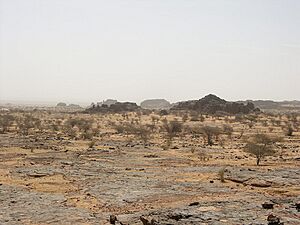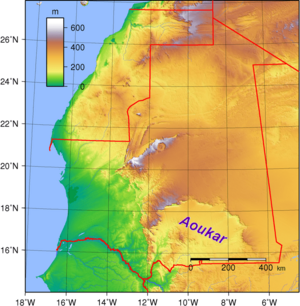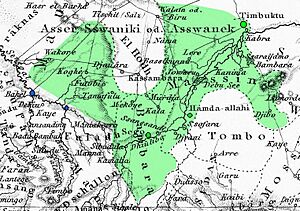Aoukar facts for kids
Quick facts for kids
Aoukar
عوكر
|
|
|---|---|

Landscape in the Ayoun el Atrous area
|
|

Location of the Aoukar basin in Mauritania
|
|
| Country | Mauritania |
| Elevation | 240 m (790 ft) |
Aoukar or Erg Aoukar (Arabic: عوكر) is a large, low-lying area in southeastern Mauritania. It's like a big bowl in the land, located between the towns of Kiffa and Néma. This area is south of the Tagant Plateau, which is a high, flat landform.
The region is also known as Hodh or El Hodh (Arabic: الحوض, lit. 'the Basin'). The Aoukar basin is mostly a dry natural area. You'll find many sand dunes here, along with salt pans, which are flat areas where water once stood and left salt behind. On its northern and eastern sides, the basin is surrounded by steep cliffs called escarpments.
Aoukar's Ancient History
Long ago, the Aoukar area was very different. It used to have a huge lake covered with reeds. This lake was so big it stretched towards the area of Tichit. It bordered the southern edge of the Tagant Plateau.
Today, the lake is gone, but we can still find clues about its past. Below the cliffs that once faced this ancient lake, archaeologists have discovered the remains of about 400 old villages! This shows that many people lived here when the area had more water.
From east to west, cliffs like Dhar Néma, Dhar Walata, Dhar Tichitt, and Dhar Tagant form a curved shape around the Hodh/Aoukar Depression. Before 4000 BCE (that's over 6,000 years ago!), this area had very large lakes. But after 1000 BCE, the region became much drier.
During a time known as the Tichitt Tradition, this area was an oasis, meaning it had water and fertile land in the middle of a desert. The Tichitt Tradition in eastern Mauritania lasted from about 2200 BCE to 200 BCE. This was a period when people lived in settled communities and farmed.
Modern History and Name
The Aoukar area was once part of French Sudan, which is now the country of Mali. However, in 1944, it was moved to French Mauritania. This change was made by a colonial governor named Laigret. Even when Mali became independent, some people there still felt that this transfer was unfair. Today, the area is mostly a dry, barren land.
The Aoukar/Hodh region is so important that it gave its name to two modern regions in Mauritania: Hodh Ech Chargui Region and Hodh El Gharbi Region.
Wildlife in Aoukar
The Aoukar is a special place for animals. It's one of the few natural safe places for the addax. The addax is a type of antelope that lives in this region. Sadly, it is a critically endangered animal, meaning there are very few left in the world. Protecting areas like Aoukar helps these rare animals survive.
See also
- Geography of Mauritania
- List of ergs



